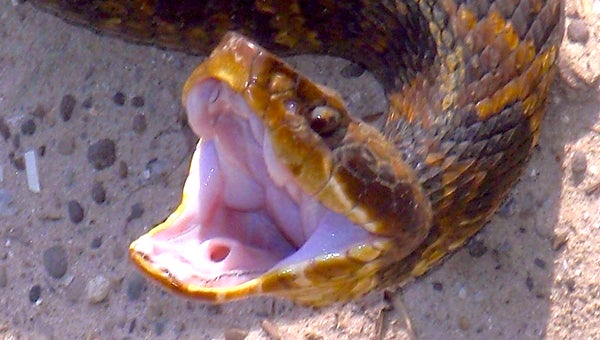Shorter days put snakes on the move
Published 3:04 pm Tuesday, September 30, 2014

FRED BONNER | CONTRIBUTED
A water moccasin shows its teeth and white mouth to warn enemies not to get any closer. The obvious white mouth display gives meaning to the nickname “cottonmouth.” This snake is one of North Carolina’s more aggressive and dangerous snakes. The white mouth display is often the only warning that enemies receive before the snake strikes-out at an aggressor.
Hunters (and fishermen) who are on the move during the early days of fall should be aware that they are not the only ones moving about. As the days grow shorter and there’s a hint of cooler weather approaching, some of our notorious eastern North Carolina snakes begin to try to bulk up on food for the winter.
Dove hunters in particular are seeing more snakes, as farmers harvest the fields. Small rodents such as field mice are looking for another place to live. Predators such as hawks and owls find easy pickings, as these small rodents make themselves more exposed. Snakes, such as blacksnakes, brown water snakes and the more lethal snakes like rattlesnakes and water moccasins, also find that mice are easier prey.
Dove hunters who tend to hide in small ditches beside newly harvested fields often have a surprise waiting for them in these ditches. The field mice have been living in these ditches that offer them a hiding place with water close by and easy access to grain in the fields. These ditches act as virtual condominiums for small rodents and “grocery stores” for snakes and other predators, such as skunks and bobcats. Some of these snakes are dangerous not only to the mice, but to hunters as well.
Rattlesnakes will usually give you a warning “buzz” before they strike. Outdoorsmen who have made themselves aware of the distinctive sound of this snake’s warning buzz compare the sound to a 17-year locust’s whine — the rattlesnake’s warning being a bit more of a raspy, dry sound. It’s a sound that can back a person up in a hurry.
The water moccasin’s natural coloring lends itself to the swamps, mud, shadows and rotting vegetation, so it’s not easy pick out from its surroundings. They don’t usually make much noise before they strike at an intruder who might venture into their domain. The best warning they offer to someone who’s getting too close is the sudden “blooming” of a white patch against a dark background. That white mouth is saying to an attacker, “Get away! I can hurt you!”
Several years ago, I was picking my way around a farm pond where the banks were over-grown with brush and downed tree trunks. As I stepped off a log and was already headed down, the sudden white “warning spot” appeared directly where my left foot was headed. I don’t know how I did it but I turned around in mid-air and wound up on the opposite side of the log where the cottonmouth had just warned me to get away. The snake missed me, but my pistol bullet didn’t miss the snake’s head.
I’m a great fan of kayaking, but when kayakers venture into the swampy creeks that cottonmouth’s favor, you’d best be prepared to have an encounter with one of our aggressive snakes. Being rather low slung and low in the water, the kayak is very open to an attack by a mad, curious or even tired cottonmouth that might think that your kayak is a floating log — a good place to rest. Slapping it with your paddle will usually turn a cottonmouth away, but I sometime carry a .22 revolver along with me to do the job when the paddle fails. A .22 long rifle load of rat-shot is a commendable deterrent to a snake at close range.
Friends have seen me stop my car and get out to move a large rattlesnake from the road before it was run over. I have a lot of respect for this snake, one that usually retreats when approached by an aggressor. When a retreat fails, the distinct rattlesnake’s buzzing sound usually works. Rattlesnakes, all species, are considered to be endangered and are protected in North Carolina There are cases where someone who kills rattlesnakes is charged with a violation of the Endangered Species Act.
On the other hand, cottonmouths are not protected and after having had several of my dogs bitten by water moccasins, I don’t have much use for this particular snake. Dogs usually recover from a snakebite, but a veterinarian’s bill is usually pretty steep.
Many folks who live around the watery habitats favored by cottonmouths try and kill every snake they see in the water. To them, if it’s in the water it must be a cottonmouth, so killing it quick before it hurts somebody is their rule of thumb. Most of the snakes you see in and around the water are brown water snakes and are not only harmless, but they also help to keep the population of rats and mice under control.
The short, chunky body shape, distinctly flattened and triangular head shape and white-mouth open warning maneuver of the true water moccasin distinguishes the cottonmouth from the more slender body and streamlined head of the harmless water snakes.
Don’t make the mistake of thinking that snakes disappear when cold weather moves into North Carolina. I’ve seen cottonmouths crawling across the ice in the swamps where we hunt wood ducks. They moved slowly, but they were definitely out and about.





